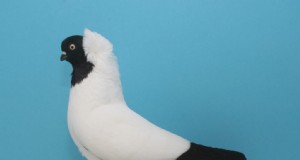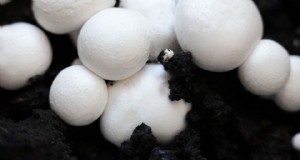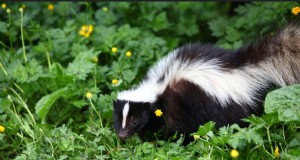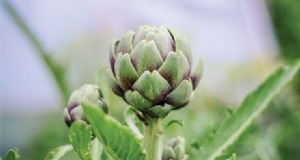UNE je r – B en train de respirer F est h c ultime ré
Les guillemots et les poissons-chats sont connus pour leur estime et la bonne demande du marché en raison de leur faible teneur en matières grasses et de leur faible nombre d'épines intramusculaires. Les poissons qui respirent l'air sont robustes et capables de respirer l'air atmosphérique avec leurs organes respiratoires accessoires. En raison de la présence de ces organes respiratoires accessoires, ces poissons peuvent survivre quelques heures en dehors de l'eau. Ces organes respiratoires accessoires sont des arbres respiratoires dans Clarias , organe labyrinthique dans Channa , vessie à air dans Hétéropneustes , chambre branchiale chez les poissons ci-dessus, etc. et sont capables d'engloutir l'air. Ceux-ci peuvent être cultivés dans des zones à faible teneur en oxygène dissous telles que les eaux sales peu profondes, étangs et marais abandonnés. En raison de leur capacité à vivre hors de l'eau, leur culture implique un faible risque et une gestion simple.
En Inde, Andhra Pradesh, Assam, Uttar Pradesh, Madhya Pradesh, Tamil Nadu, Karnataka, Maharastra, Le Bihar et le Meghalaya abritent la plus importante pêcherie naturelle de poissons à respiration aérienne. Ces poissons sont de nature carnivore et ils s'adaptent parfaitement à l'alimentation complémentaire. Comme il n'y a pas beaucoup de gaspillage d'énergie par la respiration par les respirateurs d'air croissants des eaux peu profondes, on pouvait s'attendre à de bons rendements.
Les espèces cultivables de poissons à respiration aérienne sont la Fig. 9.1
C h une nn une s t r une ce vous s – Grand guillemot ou poisson à tête de serpent
C hann une ponctuer s – Guillemot marmette
Channa marulius – Guillemot géant
Clarias batrachus – Magur
Hétéropneustes fossilis – Singhi
Anabas testudieus – Koi ou perche grimpante.
Parmi ces Channa striatus a la plus forte demande sur les marchés et commande également un prix plus élevé. Les meilleurs suivants sont Clarias et Hétéropneustes . La culture des espèces ci-dessus est rentable.
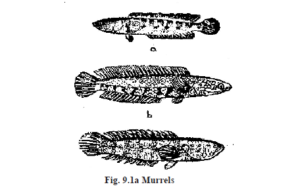
a) Channa marulius b) Channa straitus c) Channa punctatus
Cu je tourbe je e Région s
L'élevage de poissons à respiration aérienne nécessite des eaux peu profondes d'une profondeur de 50 à 75 cm. Les étangs destinés à la pisciculture à respiration aérienne n'ont pas besoin d'être fertilisés par des produits chimiques. Les poissons à respiration aérienne peuvent également être élevés dans des cages dans des systèmes d'eau courante tels que des ruisseaux, canaux et les eaux ingérables comme les réservoirs. La pisciculture à respiration aérienne s'adapte aussi bien dans les eaux impropres aux espèces classiques de carpes cultivables que dans les étangs d'élevage de carpes. Les étangs peu profonds sont utiles pour les poissons, dans lequel le poisson doit dépenser moins d'énergie pour se rendre à la surface pour absorber l'oxygène atmosphérique.
Voir ré collection m
La graine de guillemot, magur et singhi sont collectés dans les ressources naturelles, malgré le succès obtenu dans la sélection induite. Même aujourd'hui, les graines récoltées dans la nature continuent d'être la source de matériel la plus fiable pour le stockage. Les guillemots atteignent la maturité en deux ans et se reproduisent tout au long de l'année. Les alevins de 2 à 4 cm peuvent être ramassés toute l'année et dans les fossés pluviaux et les plans d'eau peu profonds avec de nombreuses mauvaises herbes. Cependant, le pic de frai est connu juste avant les moussons.
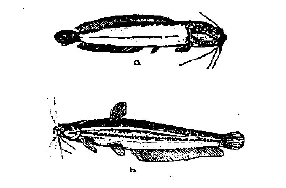
a) Clarias batrachus b) Heteropneustes fossilis
Les jeunes qui sortent des œufs se déplacent en bancs et leur collecte en grand nombre est toujours aisée. Les alevins peuvent ne pas avoir tendance à se déplacer en bancs. Les alevins de guillemots géants peuvent être identifiés par leur corps gris foncé et une bande latérale jaune orange de l'œil à la nageoire caudale. Les alevins de guillemots rayés ont un corps rouge vif avec une bande dorée rougeâtre et une bande noir foncé de l'œil à la nageoire caudale. Les alevins de guillemot marmette sont reconnaissables à leur corps brun foncé avec une bande latérale jaune doré et une ligne dorsale jaune médiane sur le dos.
Dans la culture des guillemots, il est préférable de stocker les alevins plutôt que les alevins. Le cannibalisme est présent chez les alevins de guillemots. Le taux de survie des alevins produits par la reproduction induite sera faible et il est difficile de maintenir le frai et de le faire grandir jusqu'au stade d'alevin. La ponte ne mange rien pendant deux jours après sa sortie des œufs. D'où, les alevins doivent être entraînés à accepter de la nourriture supplémentaire dans des étangs séparés. L'aliment complémentaire se compose d'œufs durs, pupes de vers à soie, du poisson et des vers hachés avec de la levure et de la vitamine B.
Il est administré pendant environ 15 jours à raison de 20 % de leur poids corporel total. Les alevins atteignent le stade de fingerling de 4 à 6 cm de long en un mois.
Les poissons-chats se reproduisent deux fois par an avec la saison de reproduction maximale pendant la saison des pluies. Les alevins de Magur sont reconnaissables à leur nageoire dorsale plus longue et à leur couleur ardoise. Les alevins Singhi ont une courte nageoire dorsale et une couleur rose. Les alevins de Koi peuvent être identifiés par la tache sombre sur le pédoncule caudal et la teinte verdâtre sur la surface dorsale du corps. Les magurs font un trou de 25 cm de profondeur dans la digue sous la surface de l'eau. Les œufs fécondés adhèrent à l'herbe et sont gardés par les mâles. 2, 000 – 15, 000 alevins peuvent être collectés dans chaque trou à l'aide de petits filets à main à mailles fines et élevés en pépinière jusqu'à ce qu'ils atteignent le stade d'alevinage avec une longueur d'environ 5 cm.
Magur peut être cultivé dans des étangs pour la production d'alevins. Des compartiments de 1 X 1 m de grillage sont réalisés sur les marges de la bund. Au centre de chaque compartiment, un trou de 30 cm de diamètre est creusé et est pourvu de quelques plantes aquatiques. Après avoir libéré les deux sexes, Environ 5, 000 alevins peuvent être collectés dans chaque compartiment en 10 jours. Les mâles et les femelles peuvent également être élevés dans de petits étangs en terre. Ils peuvent être stockés 20, 000 / étang et nourris soit avec du zooplancton filtré, soit avec de la farine de poisson hachée et des tourteaux d'arachide. Les alevins peuvent être élevés 15 jours en pépinière.
La haute saison pour la collecte des graines de singhi est la période précédant l'hiver, lorsque le paddy est récolté et que les champs de faible altitude sont exposés.
Voir ré tr une nspor t
Les alevins ou les alevins de poissons à respiration aérienne peuvent être transportés sans emballage d'oxygène. Les fûts en polyéthylène ou en fer sont utilisés pour le transport des alevins ou des alevins. Le porteur doit disposer de suffisamment d'espace pour que son revêtement habituel respire l'air atmosphérique. Le porteur doit avoir une petite quantité de mauvaises herbes aquatiques comme Vallisneria, Hydrille , Myriophylle et Ceratophyllum . Les mauvaises herbes peuvent aider à éviter de sauter du poisson pendant le transport. Si la distance est plus, il est préférable de les transporter dans des conteneurs en polyéthylène emballés sous oxygène.
Pon ré maman m ageme m t
Les pépinières mesurent environ 10 à 15 m2, ayant une colonne d'eau de 50 cm. Ceux-ci sont stockés avec 0,2 à 1,5 million d'alevins / ha. Avant le stockage, la fumure se fait avec de la bouse brute de bovin à raison de 500 Kg/ha seule. L'émulsion savon-huile pour éradiquer les insectes est appliquée sur l'eau de la pépinière. Les alevins et alevins de magur et de singhi collectés dans les ressources naturelles nécessitent une gestion en pépinière, mais les guillemots doivent être entraînés dans des étangs d'alevinage avant d'être repeuplés. Après la gestion de la pépinière, les alevins doivent être transférés dans des étangs d'empoissonnement.
Stoc k dans g
Des alevins de taille uniforme sont choisis pour l'empoissonnement. Les alevins sont désinfectés avec une solution à 2 % de KMNO4 pendant 5 minutes ou plongés dans une solution de formol à 200 ppm pendant 50 secondes avant le stockage. Les alevins blessés sont traités avec 0,3 % d'acriflavine pendant 5 minutes.
Ces poissons peuvent s'échapper en grimpant ou en creusant des terriers. D'où, les diguettes de l'étang doivent être fermes avec des bûches ou du bois lourds, ou clôturé avec de la canne de bambou ou des grillages sur une hauteur d'environ 50 cm.
Plus d'alevins peuvent être stockés dans leur système d'élevage. 40, 000-60, 000 systèmes.
alevins/ha de silures peuvent être stockés en monoculture Dans les systèmes de polyculture 20, 000 – 30, 000 alevins/ha de chat
les poissons peuvent être empoissonnés. Dans les systèmes de monoculture, 15, 000 alevins/ha de guillemots géants, 20, 000/ha en cas de guillemot marmette et 20, 000 – 30, 000 / ha en cas de guillemot marmette ensemencé. Dans les systèmes de polyculture, le guillemot marmette et tacheté peut être stocké à raison de 20, 000 alevins / ha dans un rapport de 1:1.
La polyculture de guillemots – carpes et poissons-chats – carpes est également possible avec des soins et une gestion appropriés. Les graines de poissons à respiration aérienne ne doivent être stockées que lorsque les carpes ont atteint un minimum de 300 gr, afin que les poissons respirant l'air ne puissent pas s'attaquer aux carpes. Avec ça, non seulement un revenu supplémentaire peut être obtenu grâce à la production de poissons à respiration aérienne, mais aussi la croissance des carpes peut être améliorée. Le plus tard est possible, comme les poissons de rebut qui peuvent rivaliser avec les carpes pour la nourriture et l'espace, sont éradiqués par les reniflards croissants.
Alimentation g
Pour maintenir un approvisionnement alimentaire abondant pour les respirateurs d'air en croissance, l'étang d'empoissonnement doit être riche en source de nourriture animale comme les têtards de grenouilles et les poissons de rebut. Si cette source de nourriture n'est pas suffisante, le tilapia peut également être cultivé dans des étangs à guillemots et à chats. Le poisson de rebut marin séché est également utilisé dans la pisciculture et est plus économique. L'alimentation peut être donnée aux poissons-chats avec des abats de poisson ou des déchets d'abattoir ou des pupes de vers à soie séchées mélangées avec du son de riz et des tourteaux dans le rapport de 1 :1 :1 :1. Un mélange de tourteaux, le son de riz et la bouillie de biogaz dans un rapport de 1 :1 :1 ont fourni avec succès une alimentation à faible coût pour le singhi. Le son de riz et l'alimentation de volaille en 3 : 1 et le lisier de biogaz et le son de riz en 1 : 2 doivent également être donnés à raison de 5 à 8 % du poids corporel.
Pendant les huit mois d'élevage semi-intensif en étangs stagnants, le stock de poisson-chat respirant peut être nourri au rythme suivant quotidiennement pendant les heures sombres de la journée pour obtenir une meilleure utilisation des aliments (tableau 9.1).
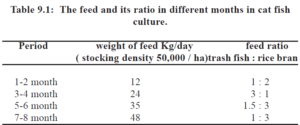
L'aliment peut être soit diffusé dans l'étang en petites quantités à partir de la digue ou peut être servi dans des paniers d'alimentation abaissés près de la berge en plus de la diffusion d'aliments pour assurer la disponibilité de l'alimentation pour tous les poissons de l'étang. Des pièges lumineux peuvent être installés dans les étangs à guillemots, par lequel les insectes peuvent être attirés par la lumière et utilisés par les guillemots comme aliment riche en protéines.
Les alevins de guillemots entraînés accepteront également des poissons de déchets marins séchés à bon marché trempés dans l'eau, qui peuvent être fournis selon le programme d'alimentation suivant (tableau 9.2). Les déchets d'abattoirs et les pupes de vers à soie comme source de protéines animales peuvent également être utilisés.
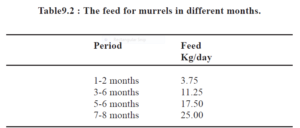
Gr o poids h une m ré p r od vous ct je o m
Les guillemots et les poissons-chats atteignent une taille commercialisable en quelques mois respectivement. Si les pratiques de gestion sont appropriées, les guillemots géants et rayés peuvent atteindre une croissance de 1 à 2 kg/an. et 0,75 kg/an. respectivement, tandis que les guillemots tachetés atteignent 160 gr. en 8 mois. Les poissons chats sont connus pour croître lentement par rapport aux guillemots. Magur et singhi atteignent respectivement 0,2 kg et 0,1 kg. Le taux de conversion avec l'alimentation recommandée est d'environ 2 : 1.
Les guillemots avec des poissons fourrages comme nourriture supplémentaire produisent environ 4 tonnes/ha/an. Magur avec aliment complémentaire de poisson séché et de son de riz, donnent une production de 10 tonnes/ha/an. Singhi donne un rendement de 4,4 /tonnes/ha/an. Polyculture de guillemots et de carpes koï, nourris au son de riz, tourteaux de moutarde et poisson poubelle, donner une production de 11,8 tonnes/ha/an, tandis que le magsur et le singhi nourris avec du son de riz et des poissons de rebut donnent un rendement de 5 tonnes/ha/an. L'élevage mixte de 3 espèces de guillemots produit 4 tonnes/ha/an lorsqu'il est nourri avec des poissons de rebut marin trempés et séchés et des pupes de vers à soie fraîches comme nourriture . En culture intensive, magur peut donner 7 tonnes/ha/5 mois.
C ul t tu es e w je t h Californie r p s
Avec une densité de stockage de 5000/ha de carpes indiennes et chinoises et 1000 alevins de magur produisent 2518 Kg/ha/an de carpes et 3711 Kg/ha/an de magur. Cela indique que la polyculture est plus rentable, et il est utile d'inclure le magur dans le système d'élevage de la carpe. Avec une densité de peuplement de 20, 000/ha de magur avec des restes de carpes (après récolte partielle des carpes) une production de 3,96 tonnes/ha/an est obtenue avec un ratio de son de riz de 50 :30 :17 :3, farine de poisson, tourteaux d'arachide et minéraux comme aliment complémentaire. Le magur convient à la pisciculture composite de carpes à la place de la carpe commune. Magur, koi et singhi sont également adaptés à la culture avec une carpe makhana à prix très élevé, Euryale ferox .
Har v estin g
La saison estivale est idéale pour récolter l'air - respirer les poissons des étangs. L'étang est vidé et les poissons sont pêchés à l'aide d'épuisettes ou de filets à main. En raison de leur forte demande et du prix du marché, la culture de ces respirateurs d'air fournit des revenus rentables aux pisciculteurs avec des techniques de gestion simples.
C une g e culte vous r e
Les respirateurs d'air peuvent également être cultivés dans des cages. Les cages sont préparées avec des nattes constituées de bambou fendu dans les eaux courantes. La zone optimale de la cage mesure 2 m X 1 m X 1 m. Le haut de la cage est à moitié recouvert de natte et la partie découverte est recouverte d'un filet pour faciliter l'alimentation et empêcher les poissons de s'échapper. Le treillis en fibres synthétiques est également utilisé pour préparer les cages.
Magur sont stockés à raison de 200/cage, nourris avec 10 % du poids corporel de poissons de rebut séchés, tourteaux et son de riz et produisent 10 – 12 Kg/m3/an. Singhi produit 12 à 20 kg/m3/an avec une densité de peuplement de 100 à 150/cage et 10 % du poids corporel des nymphes de vers à soie, son de riz et tourteau d'huile de moutarde. Les Koi produisent 4,2 kg/m3/an avec un taux de charge de 50 à 100/cage avec la même nourriture que les singhi. La guillemot marmette produit 4 kg/m3/an avec du poisson de rebut et du son de riz. D'où, la pisciculture respirant l'air est très rentable, ainsi qu'une riche source de protéines animales. Ce poisson est considéré comme un délice, et commande un prix très élevé et une demande continue sur les marchés.
T R OU T UC L T UR E
La truite est cultivée soit comme poisson de consommation, soit comme poisson de sport, sont relâchés dans les eaux naturelles pour les pêcheurs sportifs. La truite est populaire parce qu'elle est attrayante, poisson de combat actif et fournit une viande de très haute qualité. Des truites ont été relâchées et élevées dans l'eau partout dans le monde. Les truites sont cultivées à une échelle commerciale aux États-Unis depuis très longtemps. Sa culture en Europe remonte à 400 ans. C'est un poisson d'eau froide. Il habite principalement les rivières, ruisseaux, ruisseaux, lacs et étangs. En Inde, on le trouve au Cachemire, Himachal Pradesh, Uttar Pradesh, Nilgiris, Collines de Kodai et haute chaîne de Munnar.
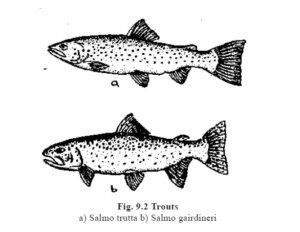
De nombreuses espèces de truites sont cultivées, mais les trois plus communes d'entre elles sont la truite arc-en-ciel, Slamo gairdneri ou Oncorynchus mon baiser, la truite fario d'Europe, S.trutta (Fig. 9.2)et l'omble de fontaine, Salvelinus fontinalis. Les truites ont un corps fuselé, ouvertures branchiales étroites et branchies réduites. Les truites sont adaptées aux eaux très oxygénées et aux températures de congélation. Les truites ont un grand pouvoir de locomotion avec des habitudes de s'accrocher et de creuser. La bouche est modifiée avec des lèvres râpeuses pour la collecte de nourriture à partir de cailloux, rochers, etc..
S p euh m dans g
La saison de frai de S.gairdneri est de septembre à février, S.trutta est d'octobre à décembre et S.fontinalis est d'octobre à janvier. Les truites préfèrent un substrat graveleux pour protéger leurs œufs et les œufs adhèrent au gravier et aux débris. Les truites construisent des nids et frayent dans les lits des cours d'eau. Les cultivateurs autorisent la fertilisation artificielle, parce que la fertilisation du lit du cours d'eau entraîne un taux d'éclosion inférieur à celui de la fertilisation artificielle. La manipulation de la photopériode et de la température de l'eau peut être utilisée pour induire la maturation gonadique, de sorte que les jeunes poissons sont générés tout au long de l'année. Les truites sont capturées à maturité ou presque lorsqu'elles nagent en amont et sont élevées jusqu'à maturité dans les étangs. Les géniteurs sont placés dans de petits étangs avec de l'eau courante et sont souvent recouverts de filets pour les empêcher de sauter. La laitance d'un seul mâle peut être utilisée pour féconder deux femelles, de sorte que plus de femelles sont ensemencées avec peu de mâles.
Les truites présentent un dimorphisme sexuel. Les mâles deviennent de couleur plus vive et la mâchoire inférieure développe un bec crochu pendant la saison de reproduction. Les femelles développent un ventre allongé et la papille génitale devient plus grosse et rougeâtre. Lorsqu'ils sont à pleine maturité, la laitance ou les œufs sortent avec peu de pression sur l'évent abdominal. Quand la truite est mûre, les poissons femelles sont dépouillés et les œufs collectés dans un récipient en émail ou en plastique de couleur noire auquel la laitance du mâle est ajoutée et mélangée soigneusement avec une plume pour la fécondation. L'eau est ajoutée après le mélange et l'eau fait gonfler les œufs. L'eau ne doit pas être ajoutée avant le mélange, car la motilité des spermatozoïdes est considérablement réduite en présence d'eau. Pour assurer un meilleur taux de survie, les œufs peuvent être recueillis dans une petite quantité de solution saline (10 litres d'eau douce + 90 g de sel commun + 2 g de chlorure de potassium + 3 g de chlorure de calcium). Les œufs fécondés développent une teinte verte et sont appelés « verts », qui sont ensuite transférés dans des écloseries. Avant le transfert, retirez les particules étrangères et les œufs morts.
T ra ns p o r t à je o m o F t déroute e gg s
Les œufs fécondés et durcis (durcis pendant 24 heures) de truite sont transportés dans des cartons de dimensions 20 X 30 X 20 cm. Le côté intérieur de la boîte en carton est doublé d'une doublure en polystyrène. Deux éponges humides ou des cotons sont disposés, un sur la face inférieure et l'autre sur la face supérieure. Sacs en polyéthylène poreux contenant environ 4, 000 œufs sont placés entre les éponges humides et les cotons. Un sac en polyéthylène avec de la glace brisée IKg est conservé pour le maintien à basse température, au-dessus du coussin supérieur. Ces cartons sont transportés à divers endroits.
Couvoir oui technique h nique s
Les œufs de truite sont incubés en les gardant dans des auges en béton avec des plateaux plats et disposés horizontalement, incubateurs ou pot. Les écloseries doivent être équipées d'eau douce filtrée et sans limon en circulation. Autrefois, des paniers étaient utilisés pour l'incubation. Les incubateurs à flux vertical sont les plus courants. Il a beaucoup d'acier inoxydable, de fibre de verre, aluminium, ou en bois, ou PVC, ou plateaux en plastique, disposés l'un au-dessus de l'autre. Les fonds des plateaux sont pourvus de tôles de zinc perforées, grilles en verre ou en toile grillagée pour assurer le passage de l'eau à travers les différents bacs. La taille peut varier de 180 X 30 X 10 cm à 500 X 100 X 50 cm. Chaque plateau a un panier à œufs supérieur et un compartiment inférieur perforé sur lequel repose le panier. Les œufs sont placés dans le panier pour l'incubation. L'eau est introduite dans le bac de telle sorte qu'elle remonte à travers le panier contenant les œufs, puis vers le plateau ci-dessous et vers le haut à travers ce panier et ainsi de suite à travers l'incubateur. Ce flux d'eau ascendant à travers les œufs permet une aération accrue et facilite l'élimination des métabolites.
Les pots à couver sont également utilisés pour l'incubation des œufs de truite. Il se compose d'un écran galvanisé de maille de 0,5 mm avec un lit de gravier au fond, juste au dessus de l'entrée. Ce lit de gravier est utile comme filtre pour éliminer les particules indésirables. Les œufs sont placés au-dessus du filtre pour l'éclosion. L'eau a traversé l'entrée, remonte à travers le filtre et les œufs et s'écoule par la sortie. Après l'éclosion, les nouveau-nés sont maintenus quelque temps dans les bocaux.
Les œufs sont très sensibles pendant la période d'éclosion. Les œufs nouvellement fécondés peuvent être tués s'ils sont directement exposés au soleil. Pendant l'incubation, l'eau doit être en mouvement et avoir une teneur élevée en oxygène. L'incubation se déroule normalement dans de l'eau à une température de 8° -12°c. Les alevins peuvent être conservés dans les plateaux jusqu'à ce qu'ils deviennent actifs et puissent commencer à se nourrir. Ils peuvent être relâchés pour être repeuplés dans les eaux naturelles.
Cu je tu ré o F t rou t s
Les alevins sont élevés dans de petites auges d'élevage avant d'avoir complètement absorbé leur vésicule vitelline, et initier à vivre sur des aliments artificiels. Ensuite, ils sont transférés dans des étangs d'alevinage pour être élevés jusqu'au stade d'alevin avancé. Les étangs d'alevinage peuvent être en béton ou en pierre avec des dimensions de 2,5 X 1 X 0,75 m à 9 X 1 X 0,75 m. Le débit d'eau peut être maintenu à 100 l/min. à l'intérieur du bassin d'alevinage.
Les alevins avancés sont élevés jusqu'aux adultes dans des étangs d'élevage et des raceways. L'étang d'élevage est un plan d'eau naturel, et un chemin de roulement n'est qu'un étang à poissons d'eau courante. La taille des canalisations doit être comprise entre 20 et 100 m2 avec une profondeur de 1,5 m. Une série de chemins de roulement sont construits de chaque côté du ruisseau ou de la rivière. Chaque chemin de câbles reçoit de l'eau du ruisseau et l'eau sort du chemin de câbles par la sortie qui se trouve du côté opposé. Des écrans en tôle de zinc sont utilisés aux entrées et aux sorties. Le débit d'eau est maintenu à 50 l/sec, dans les étangs de la rivière. Des étangs circulaires et ovales sont utilisés aux États-Unis. Le taux de stockage peut être limité pour produire 5-10 Kg/m2. Production élevée de 200 Kg/mis également possible dans les raceways, si la gestion est bonne.
L'élevage de truites en cage est également courant. Dans une expérience, les alevins ont été stockés à 1,4 kg/m2 dans des cages et nourris 3 % de leur poids corporel par jour. Ces truites ont atteint 27-88 gr. dans deux mois. L'aliment donné aux truites comprend la rate de bétail, le cœur et les poumons et les déchets marins ou d'eau douce. De nombreux aliments commerciaux pour truites sont disponibles sur le marché. Les truites sont nourries 3 à 4 fois par jour. Il existe plusieurs façons de nourrir les truites. L'aliment est soit pulvérisé à la surface de l'eau, ou la nourriture peut être conservée dans un sac ou dans un récipient dans le coin de l'étang. Il est utilisé pour les départs à la demande, dans lequel chaque fois qu'une truite heurte la gâchette, la nourriture est libérée dans l'eau, ou des mangeoires automatiques peuvent également être utilisées. Les bocaux et les tambours sont également utilisés pour l'élevage des alevins de truite.
Se w ag e – Fe ré F je s h Cu je tu ré
Les eaux usées sont nuageuses, fluide sale et odorant de nos toilettes et cuisines de nos maisons. Il contient des minéraux et des nutriments organiques à l'état dissous ou dispersés à l'état solide. L'évacuation des eaux usées est devenue un problème mondial en raison de l'urbanisation. C'est un effet de démophora, c'est-à-dire une croissance ininterrompue de la population humaine. Dans les années récentes, les eaux usées sont devenues un polluant majeur des eaux intérieures, surtout les rivières. Elle est à l'origine de nombreuses épidémies. Il est responsable d'une grave menace pour les écosystèmes du sol et de l'eau. L'approche de l'élimination des eaux usées devrait être l'utilisation de ces résidus avec le concept de leur réutilisation ou de leur recyclage à travers un système écologiquement équilibré impliquant principalement l'aquaculture. L'utilité des effluents d'eaux usées pour améliorer la fertilité des étangs d'eau douce est connue depuis longtemps dans de nombreux pays du monde.
La quantité d'eaux usées produite est l'Inde en 3,6 mm3/j (millions de mètres cubes par jour) ou 800 mg/j (millions de gallons par jour). Environ 30 % (1,9 mm3/j) sont produits dans les centres urbains. Seulement 1,3 mm3/j (20,4 % du total d'une journée en Inde) est traité dans ces centres. Près de 80 % du total d'une journée du pays reste encore à traiter et à utiliser. La quantité de fumier obtenue à partir d'une journée de production d'eaux usées en Inde est d'environ 0,126 m.tonnes. Cela équivaut à 46 m.tonnes/an. Le fumier des eaux usées d'une journée est suffisant pour cultiver 0,1 m.hectare de récolte annuelle de poissons. Les eaux usées sont également utiles pour l'élevage des poissons. En Inde, on ne trouve que 130 fermes piscicoles alimentées par les eaux usées, couvrant une superficie de 12, 000 hectares. Les pêcheries alimentées par les eaux usées de Vidyadhari près de Calcutta en sont un exemple, où les pêcheurs ont pleinement profité des systèmes d'évacuation des eaux usées de Calcutta. Ici, le rendement en poisson est d'environ 1, 258 kg/ha. La capacité de fumure élevée est combinée avec la possibilité de servir de source d'eau supplémentaire pour la pisciculture et d'améliorer la production de poisson.
Co m position t io m o F sewa g e
La composition des eaux usées varie d'un endroit à l'autre et selon la saison. L'eau est un composant majeur des eaux usées (99%) et la suspension solide dans les eaux usées ne représente que 1%. En moyenne, les eaux usées des villes indiennes contiennent 52 ppm d'azote, 16 ppm de phosphore, 45 ppm potassium and 350 ppm biodegradable organic matter. The organic carbon component is 25-40 ppm, the ratio of carbon and nitrogen being 1:3. Salts of several heavy metals such as Zn, Ni, Cr, Pb, etc. are also found above the permissible levels in sewage. The organic refuses in the sewage have proteins, carbohydrates and fats in varied proportions depending on the nutritional status and food habits of the population. Among carbohydrates, readily degradable starch, sugar and cellulose are detected.
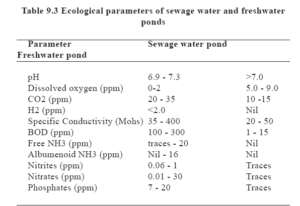
Some ecological features of different waters are mentioned in Table 9.3. Sewage water has high BOD (Biological Oxygen Demand) and Oxygen Consumption (OC) values. Dissolved oxygen becomes depleted in sewage water due to high oxygen demand and low photosynthetic rate. Photosynthesis is low because of poor illumination as the suspended solids in sewage water obstruct sunlight. En moyenne, strong, medium and weak sewage consist of 1200 ppm, 720 ppm and 350 ppm of total solids respectively, out of which 850 ppm, 500 ppm and 250 ppm occurs in a dissolved state and 350 ppm, 220 ppm and 100 ppm is found in suspended form. Dissolved salts being very high in sewage water, manifest high specific conductivity. Production of acids in high amounts render the water acidic, making the medium unfit for supporting life (Fig. 9.3). Acidity of water below pH4 is known to kill the flora and fauna.
Sewage enriches water with organic matter that begins to decompose aerobically thereby depleting dissolved oxygen and leading to anoxic condition. Anoxia causes non-mortality of animals, adding organic matter further to the already rich organic content. In the absence of dissolved oxygen the organic matter undergoes anaerobic decomposition as a result of which obnoxious gasses like H2S, CH3 and CO are produced. These gasses besides being toxic, react with water to form acids.
Immediate effect of sewage on the biota is eutrophication. Sewage water stimulates rapid growth of phytoplankton leading to an algal bloom followed by rapid increase in zooplankton. For utilizing sewage in aquaculture, the properties such as the concentration of dissolved and suspended solids, organic carbon, nitrogen and BOD are essential.
Micro b iolog je Californie je c harac t arist je c s
Harmless and even useful non-pathogenic bacteria are present in much greater numbers in domestic sewage as compared to pathogenic bacteria comprising mostly the intestinal microorganisms found in the community producing the waste. Usual load of coliform bacteria in raw sewage ranges between 108 and 109 MPN/100ml.
Si t e s e lect je o m une m ré c onst r ucti o m o F se w age- F e ré fis h loin m
Fish farm in the vicinity of an urbanized area has the scope to receive domestic sewage for the recycling of nutrients. Any area adjacent to a municipal sewage treatment plant is ideal for the location of a sewage-fed fish farm. The fish farm site should be at a lower level than the treatment plant so that the sewage can easily enter into the pond through a pipeline by gravity. The fish farm should have facilities of draining out water from the ponds.
The plan of the fish farm depends upon the source of the sewage, system of culture and topography of the land. Nearly 75% of the total area is converted into ponds leaving the rest for dykes and other purposes. Rectangular fish ponds of 0.3 to 1 ha are constructed with a slope of 1:3 for the embankment and maximum depth of 1.5m. Each pond should have proper drainage facilities.
The effluent is collected in a sump at the farm, from where the effluent is taken into the ponds through the distributing system. Additional arrangement is made to connect the pipelines with freshwater supply for emergency dilution.
S e remuer e tr e à moi m t
Sewage treatment is necessary to kill the harmful microbes, prevent anoxia, raise the pH to an alkaline level, increase photosynthesis, reduce organic content, etc. The treatment has to be inexpensive and one which induces in sewage water the conditions prevailing in a natural freshwater pond. Sewage is treated in following three ways – mechanical treatment, chemical treatment and biological treatment.
Méca une nica je t reatment:
Solids and organic matter are removed to a large extent by mechanical treatment, which involves flowing, dilution and sedimentation. Usually screening and straining of sewage it is done to remove the waste solids. The liquid and semisolid wastes are then
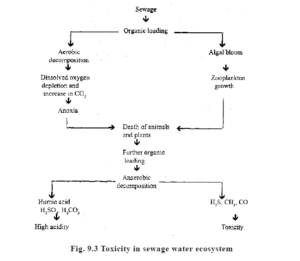
subjected to treatment for the removal of colloidal and semisolid suspension by dilution, H2S, CO2, CO, NH3, CH3 concentrations are brought below the normal levels. Ainsi, through primary treatment the supernatent effluent is separated from the sludge.
C h emic une je t reatment:
In chemical treatment, several dissolved substances, harmful germs and aggressive odours are eliminated. Inexpensive precipitants,
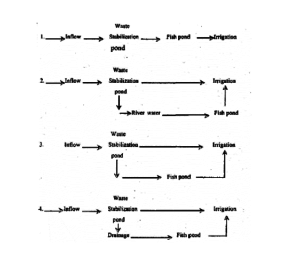
coagulants, chelating substances, disinfectants, deodorising agents, etc. are used in this treatment. The sewage water is also treated with chlorine, bleaching powder and copper sulphate. It is also known as secondary treatment.
Biol o gica je t r e ment :
In biological treatment of sewage care is taken to promote bacterial growth. Bacterial action promotes oxidation of organic matter. The end products nitrogen oxides, bring about rapid growth of algae, particularly the blue green Microcystis. This arrests anoxia of water by raising the dissolved oxygen, lowering the CO2 content and by increasing the pH from acidic to alkaline levels. The algal bloom reduces the concentration of dissolved salts in the sewage water.
Pô m ré Maman m ag e Hommes t
F e rtil je zati o m
Fertilization of sewage-fed pond is done in two phases, pre-stocking and post-stocking fertilization. In dewatered and sun dried ponds, primary treated sewage effluent is taken up to a depth of 60 – 90 cm during premonsoon months (April – May). The effluent is then diluted with rain water or freshwater till the pond BOD reduces to 50 ppm. Periodic fertilization with sewage effluent is carried out after two months of stocking to maintain nutrient status and productivity of the pond at a desired level. The quantity of sewage effluent to be allowed into a pond solely depends on its quality determined on the basis of BOD values.
Limin g
Application of lime in sewage-fed ponds is most essential. It is a useful promotor of fertility in ponds and act as a disinfectant against harmful microorganisms. Prestocking liming is recommended at a rate of 200 – 400 Kg/ha as initial dosage. Subsequent liming of 150 – 200 Kg/ha on standing crop is necessary throughout the year during sewage intake and during winter months, when parasitic infection is more.
Stoc k dans g
The cultivable species of freshwater fish such as Indian major carps and exotic carps can be grown in sewage-fed waters. Considering the high carrying capacity and high productivity of sewage-fed ponds with respect to plankton and benthic fish food concentration, fish are usually stocked at a reasonably higher density. The stocking rate recommended 10, 000 – 15, 000 /ha of carp fingerlings of about 10 gr. each and it is preferred to stock more of omnivorous scavengers and bottom feeders to maintain fish pond hygiene for higher yield. The ratio of carps for better output is rohu 2.5 :catla 1:mrigal 2.5 :common carp 2 :silver carp 2. Omnivores and bottom feeders directly consume the organic detritus of sewage-fed ponds, and thereby directly helping in keeping the pond aerobic. The stocking rate of fish is kept on a higher side considering the profuse growth of algae which will otherwise grow, decay, putrify and finally deplete the oxygen concentration of fish pond.
E c ologica je c onsideratio m s un ré une lga je suite r o je
Maintenance of aerobic conditions of the sewage-fed pond is highly essential and as such early morning dissolved oxygen level should not deplete below 2 ppm for carps. The BOD should be below 30 ppm for better survival of fishes. CO2 concentration should not be allowed to increase beyond 20 ppm to keep the toxicity level within tolerance limit for fish and to control algal blooms. Liming helps in regulating CO2. Heavy metal pollution, si seulement, can be controlled by introducing water hyacinth at the pond margins and barricading them with bamboo poles to prevent spreading of the weed throughout the water surface of the pond.
Algal control is a must to maintain proper dissolved oxygen. It should be more than 2ppm and optimal 5 – 6 ppm in a sewage-fed pond. The presence of silver carp regulate the algae in the culture system. When biological control of algal bloom is not possible, application of simazin at rate of 0.5 – 1 ppm is recommended.
Con t ro je o F une q uat je c insé c t
Aquatic insects are found in sewage-fed ponds, especially more during winter months. The insects of the pond mainly comprises hemiptera, coleoptera, odonata, zygoptera and trichoptera. Dipteran insects dominate, especially the larval stages of Chironomids associated with annelid worms of tubificidae.
Other insect larvae of the sewage-fed ecosystem belong to tubanidae, anthomyiodae, tetanocoridae, etc. The predacious hemiptera, coleoptera and a few odonata, zygoptera are needed to be controlled. An emulsion of soap and vegetable oil at a rate of 4 Kg/ha and in the ratio of 1:3 is applied to control these insects.
H arvestin g un ré oui e je ré
After 5 – 6 months culture, when the biomass grows to an optimal level, the stocking density is thinned out through periodical and partial harvesting. The water depth of the pond is reduced by dewatering for final harvest when the fishes are removed by repeated drag netting.
In a mixed culture of five carp species in sewage-fed ponds, the yield rate varies from 5.4 – 8.6 t/ha/yr with an average production of 7 tonnes/ha/yr. The fishes are around 500 gr. to 1000 gr. during culture operations.
The recurring expenditure on sewage-fed fish culture is meagre compared to that of fresh-water fish culture. This culture is lucrative and a fish farmer can obtain an income, on an average of more than Rs. 40, 000 /ha/yr. If murrels are cultured in oxidation ponds and the excess sewage is utilised for the cultivation of crops, the revenue could be further augmented.
Full utilization of sewage has manifold benefits. Outbreak of epidemics can be prevented. Biogas from sewage can be used as fuel to ease the pressure on LPG, electricity and fuel wood. Slurry from biogas plants can be used as a manure. Water reclaimed from sewage can be recycled for irrigation and pisciculture. Outre, scientific handling of sewage generates employment opportunities to educate youths. More than all these water bodies, rivers, particularly can be saved from sewage pollution by proper management.
Utilisat je o m o F Bioga s Slurr oui pour r Fi s h culte ré
In our country, especially in rural areas, mere has been a tremendous growth of biogas plants as a source of non-conventional energy. Biogas is also called as gober gas. The biogas plant is a device for conversion of fermentable organic matter, especially cattle dung into combustible gas and fully matured organic manure or slurry by anaerobic fermentation. The nutrients of the generated slurry can be harvested for production of feed and food and replace conventional inorganic fertilizers. Due to lack of knowledge and communication to farmers, most of the generated slurry is not used properly. The biogas plant can also digest night soil, poultry and piggery droppings, weeds and other fermentable materials along with cattle dung. Biogas slurry consists of 1.52 mg/lit nitrogen, 0.82 mg/lit of phosphorus and 0.83 mg/lit of potash. Biogas slurry is rich in humus and contains nutrients mostly in the available form. The oxygen demand for its decomposition is much less than for raw cattle dung or any other organic manure. Due to the high nutrients value of biogas slurry, it can be used as a fertilizer in fish culture ponds. Slurry application improves the soil structure. It enhances zooplankton production in water.
Gober gas plant is a composite unit of a digester and gas holder. Gas holder floats on the top of digestor, wherein gas is collected. In the plant, the whole system is based on continuous operation. The organic manure to be fermented is fed in semi-fluid form at the one end and the fermented spent slurry is extracted at the other end periodically with disturbing the whole system. Slurry is odourless, free from flies and other sources of infection.
In a preliminary experiment, the slurry from plant is drained into a fish pond of 0.15 ha area, which is stocked withrohu, catla, mrigal, common carp, silver carp and grass carp at a density of 7, 500 fishes/ha, resulted in production of 5080 kg/ha/11 months (762 kg/ha/0.15 ha/ 11 months).
This experiment indicates that the high production potentiality of the pond using only biogas slurry as fertilizer. In Madurai Kamaraj University, the experiments conducted with Oreochromis mossambica by using only biogas slurry as fertilizer and found the enhanced production. They indicated that males grow larger than females. They got the production of 2.4 tonnes/ha/125 days with a stocking density of 30, 000 juveniles/ha and initial size of O.Sgm. They also got 4.4 tonnes/ ha/125 days with a stocking density of 60, 000 juveniles/ha and initial size of 0.5 gm.
In a polyculture experiment with Indian major carps at ratio of 4 rohu:3 catla :3 mrigal at a density of 5000/ha by using only biogas slurry (0.15% concentration every three days) as feed and fertilizer resulted 5500 kg/ha/yr. The fishes grow well with only slurry, without any supplementary food and other fertilizers, this reduces the cost of feed and fertilizer. But there is little chance of microbial attack, it can be controlled with good management. In an experiment at ANGRAU with biogas slurry in different dosages – 5000, dix, 000 and 15, 000 kg/ ha/yr applied in different fish ponds 1/3 of the slum’ was applied initially and the remaining slurry was applied in equal fortnightly instalments. Catla, rohu, mrigal, common carp, silver carp and grass carp were stocked at a ratio of 2:2:1:1:2:2 at the rate of 5000 kg/ha. The production was obtained was 1956. 2096, and 2052 kg/ha/yr in 5000, dix, 000 and 15, 000 kg/ha/yr biogas slurry treated ponds without any supplementary feed, or organic and inorganic fertilizers. The fish production obtained was 5470, 7230 and 6050 kg/ha/yr in the above three slurry treated ponds with supplementary feed, but without organic and inorganic fertilizers. Supplementary feed was given in the form of rice bran and groundnut oil cake in the ratio of 2:1 at the rate of 5% body weight of fishes.
The experiments indicate that high production offish in biogas slurry treated ponds and at the same time the expenditure is lesser than normal culture systems because organic and inorganic fertilizers and supplementary feeds are not used. By using the waste of biogas plant in the form of slurry, profitable fish production can be obtained. Fish produced through recycling of organic manure is more healthy and has less fat accumulation. The recycling system, cependant, requires effective management. One of the problems is the difficulty in balancing the expertise needed in fish animal husbandry. Over concentration on one system may be detrimental to the other. The monitoring of dissolved oxygen level in pond water is absolutely essential when the integrated systems are adopted. Excessive manuring causes water pollution. It rapidly decreases oxygen level in the water, produces toxic gases like ammonia often leading to fish kills. Application of manure should be regulated according to the dissolved oxygen level which is very essential for the rapid growth of fishes. No serious health hazards due to slurry was noticed, though animal excreta is a potential source of infection. De plus, fermentation of the manure in a biogas plant kills and destroys the eggs of parasites.
C ag e un ré P e m Cul t vous ré
Cage culture
Fish culture in ponds is the primary method of freshwater and brackish water fish culture. Cependant, there are other methods of fish culture used in places where pond culture is not possible. Other methods of fish culture are those carried out in dams and reservoirs, cage, pens and rice fields. Due to exponential growth in population and the great pressure on land for habitation and agriculture, the large water resources such as tanks, des lacs, reservoirs and canals, which have been not exploited so far can be used for augmenting fish production. Due to the large water bodies, the management has complex problems. The best thing seems to be captive, regulated culture of suitable fishes in impoundments installed in them.
A practical approach to increase the aquaculture production could be takeup as fish husbandry in cages, pens and other enclosures in large water bodies like tanks, swamps, des lacs, reservoirs and canals along with open ranching, without prejudice to their other use. By virtue of the short gestation period, these unconventional systems yield quick results with minimum conflict of interaction on land demand with agriculture and other animal husbandry practices. Enclosure aquaculture can play a significant complementary role in augmenting yields from our capture fishery resources, especially those having large predatory fish population.
Cages and pens could be utilized as nurseries for raising fish seed and for the grow-out of table fish. They dispense with the need for land based nursery forms cutting down on the cost of seed production. Investment on long distance transport of fingerlings for stocking reservoirs and handling mortality can be avoided by insitu rearing of fry in cages and pen installed in them. One of the impoundment cultures is in cages. Many countries are practicing cage culture of fishes and prawns successfully. Cage culture has also been started in India only recently.
UNE dv une ntag e s o F cag e c ultu r e
The advantages of cage culture are
- Large water bodies could be utilized better for fish culture.
- The flowing water could be better utilized for fish culture.
- Cage culture reduces demands on prime agricultural land for fish farm construction.
- Free exchange of water.is possible in cages.
- High density stocking and intensive feeding of the stock can be achieved, which gives high yield per unit area.
- Decomposition and degradation of concentrated waste products do not arise in cage culture.
- Oxygen depletion can not be found in cages. Monitoring growth of the stock, diseases is easy.
- Considerable reduction or extreme compactness in the production area is thus achieved in cages.
- Several units of cages could be installed in a water body for gainful employment and income.
- Harvesting is simple and easy.
- Considerable indirect employment will be generated.
- With ca’ge culture, the animal protein production can be increased.
- The left over feed, faecal matter and metabolites enrich the water body in which cages are installed.
Loca t io m o F cage s
The ideal location for cages is weed-free shallow waters. Flowing water is best for cage culture. The site should have adequate circulation of water. The wind and wave action should be moderate. The water should be free from pollution and weeds. The area should be easily accessible. Cage culture can also be practiced in areas like swamps where there is water not being used for any other purpose. Seed should be available in the vicinity. A ready market for fish should be available near the site. Flowing waters with a slow current of 1 – 9 m/minute’lare considered ideal for cages. The cages should be a little away from the shores to prevent the poaching and crab menace.
T oui pe s o F c une ge s
Cages can be circular, cubic and basket like and the shape has little effect on yield rate. Cages may be floating at the surface, just submerged or made to sit on the bottom. Floating cages may be the most appropriate for Indian conditions and the experiments conducted in our country for seed rearing, grow out, nutrition and biomonitoring have been in such enclosures. The size of the cage depends on the type of culture operation and the support facilities available. Large cages are difficult to handle. Although the cost of small cages is higher, handling is easy with low risk of losses. The nursery cages are generally of the floating type, while the ground cages may be floating or immersed depending on the species cultured.
C au s vrai c ti o m o F Californie g e s
The type of material used for cages (Fig 9.4) will depend on the type of culture whether they are used for fry or table fish rearing. Bamboo interspred with wooden planks for cages is commonly used in Indonesia, Vietnam, Thailand and Kampuchia. Thick polythene fibers are used for cages in Japan. Metallic grills are used in—LISA. Aluminum frame and nylon webbing is used for fabrication of cages in USSR and West Germany. In our country, fairly fine mesh nylon netting are used. The cage material are used mainly depending on their cost and availability.
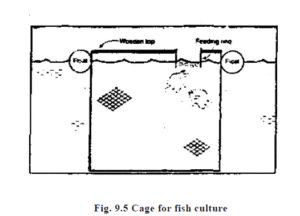
Small cages with mats of locally available plant materials such as palm leaves. Cypérus stem, Phragmites stem and split bamboo are used in India. These cages are of 1 – 2 m2 area. Split bamboos are joined with the help of coir rope or nylon twine. The cages are installed in the water body with bamboo supports at the four comers and the bottom. Materials other than bamboo mats are decayed by the third month and collapsed within a year. Split bamboo cages remain for over a year. Circular cages with thick bamboo stipes tied with nylon twine the durability of over 3 years.
Cages made up of monofilament woven material of 1 – 3 mm mesh size and 0.3 – 1 mm thickness are light and easy to handle, but remain for 6 to 12 months. The exposed part become brittle and gives way. Knotless nylon webbing of 3 – 6 mm mesh size and knotted nylon webbing of 7 -15 mm mesh have been found to be most durable. Cages made of water – proof surface painted light conduit pipe frames with a 10 m2 area are light in weight and have long durability. A battery of cages is enclosed with a bamboo catwalk and the whole structure floated by sealed empty barrels of 200 1. capacity.
The circular cages with conduit pipe structures which can be easily assembled have been designed with nylon webbing in different dimensions. These cages are floated freely on the water surface with the help of 3 – 4 sealed HDPP jerry cans. These arc extremely useful for cage culture. Due to their circular is shape the wave action in minimum. These can be moved from place to place with least water resistance. Due »their circular shape, the rearing space is maximum in side. The aeration and water circulation is better in these cages. Fishes can move in the cages with least obstruction.
Auto-floating, highly durable HDPP pipe frame nylon net cages with 36 m2 area are also used. These are light in weight and not need floats to float on the water surface.
The size of the cages depend on die scale of culture, species cultured, Infrastructure, financial and management resources. The size varies from 2- 10m3 in India, 100 – 150m3 in Indonesia, 60- 180m3 in Kampuchia. 40 – 625 m3 in Vietnam and 30 m3 in Holland. Large cages are operated in Germany with 42 m diameter and 16, 500 m3 at the water depth of 12 m. These are provided with automatic or water jet pump-feeding, special handling and harvesting accessories.
Cal t ura b je e poisson e s je m c âge s un ré t h ei r sto c proche g
The fishes used for the cage culture should be adaptable to captive culture, fast gro\vng, hardy and disease resistant. The Indian and Chinese carps, tilapia and magur can also be cultured where trash fish is cheaply and abundantly available. In Thailand and Kampuchia the cat fishes, Pangasius species are being cultured in cages successfully. Koi and Singhi are also cultured in India in cages.
En Inde, the nursery cages are stocked with carp fry at the range of 150-700 fry/in2 in caaes with different materials. In Japan 15.000-62.000 fry/nr2 of grass carp fry are stocked in nursery cages. The common carp stocking density is 150/nr2 in Kampuchia, 133 -417/nv1 in Indonesia and 80 – 360/nr2 in Vietnam. In Thailand Pangasius sutchi, P. larmmdi et P. micronemus fry are stocked at densities of 150-300/ nr2 in cages of size 1-10 m2 area with a depth of 1.5m. .
The number of fish that can be stocked in a cage is variable and depends on the canying capacity of the water area, water quality and rate of circulation, the fish species, the quality and quantity of feed supplied. A safe level may be about 3000 to 6000 fish/ ha. In able – fish rearing cages in India, the fingerlings of carps are stocked at density of 30 – 38no /m2 . The tilapia, Oreochromis mossambicus can be stocked a rate of 100 – 200 m-2. Murrels can be stocked at density of 40-100m2.
Maman m ag e Hommes t un ré oui je el ré
The cage culture can be taken up in two phases – nursery phase and table – fish rearing phase. In nursery phase of cage culture, the spawn or fry are reared to fingerling stage in 2-3 months. Different feeds can be used for culture in nursery cages. Groundnut oil cake, son de riz, egg yolk, soyabean cake, soyamilk and soya flour are used as food for fry in nursery cages. The silkworm pupae are also tried as supplementary food.
The initial size of fish to be stocked in the cages will depend primarily on the length of the growing season and the desired size at harvest. The carp fingerlings for stocking in 16-20 mm mesh cages should be over 10 gr. to expect a final size of over 500 gr. within 6 months. It should be ensured that the fingerlings used for stocking are healthy and disease free. All the fish should be actively moving. It is ideal to stock cages in the cool part of the day.
En Inde, the growing season is almost year round, except for December – January in northern parts, where the temperature is low during these winter months. Very little natural food such as plankton, insects and various other organisms enter the cages and is available to fish. Cependant, supplementary feeding is essential in the cage culture to get high production. The types of feed used will depend on the species cultured and their prevailing market prices. Murrels, par exemple, require to be fed with fish, shrimps or other animal matter. Most of the fish cultured are omnivorous and they accept both plant and animal byproducts such as oilcakes, brans, fish meal and silk worm pupae.
Cage fish are generally fed at least once daily throughout the growing period to get better growth. The quantity of feed to be given is important, since under-feeding will reduce growth and production, while over-feeding will waste costly feed and can affect the water quality. A method used to estimate the daily feed to be give in cages is based on the total weight of the fish. The feed is usually expressed on percentage of body weight. In carps, the feeding rate is 4 – 5 % of the body weight per day until they attain approximately 100 gr. And thereafter at 2 – 3 %.
In table-fish rearing phase, involving the high-tech system of saturated stocking and feeding on enriched formulated feeds, the production recorded in common carp is 25 – 35 Kg m° month’1 in foreign countries. The channel catfish, Lactarius ponctuation in USA yielded a production of 20 – 35 Kg/nr3. In Africa, tilapia yielded 17 Kg/nr3and trout produced 15 Kg/nr3. The food quotient in these cultures varied from 1.3 – 2.1. En Inde, a production of 1.5 – 2.5 Kg nr:month’1 common carp was achieved with mixed feed of silk worm pupae, ground cake and rice bran. Catla yielded 1.4 – 2.7 Kg nr2 month’1 with groundnut cake and rice bran with the food quotient 5.6. Tilapia produced 1 – 1.6 Kg nr2 month’1 with a mixture of rice bran, groundnut cake and commercial cattle feed and food quotient ranged from 1.8- 2.3 . About 1 Kg nr2 month”’ of murrel and 0.3 – 1.5 Kg nr2 month’1 of catfishes, singhi and Koi are obtained.
Californie g e cu je tu ré o F pr une propre s
The freshwater and marine prawns are also cultured in cages. The cages are stocked with wild or hatchery reared post larvae. Commercial scale rearing of post larvae in floating and fixed nursery cages (3.7 X 2.7 X 1.3 m) has been done with considerable success. They are fabricated from fine mesh (0.5 mm) nylon netting, supported by bamboo poles which are driven into the bottom of the water body. The optimal stocking density reported is 30, 000 post larvae/cage (2 .310 m’3). Feed is provided in trays fixed inside the cages. Initialement, the post larvae are fed on a paste of finely ground trash fish, later are fed with fresh mussel meat.
Pe m culte r e
Recent results in the use of cages, pens or enclosures and recirculating water systems suggest some ways of compact intensification of production in aquaculture given the accessory inputs. This practice may provide great possibilities in the future in certain selected and suitable areas.
Aquaculture in open waters through the use of pens or enclosures is also a means of minimising the limiting effect of metabolities and pollutants on cultivated stock. Greater production in very limited space has been found possible under those situations. Production figures from these types of aquaculture environments approximates to 4 -10 t/ha/yr in Laguna lake in Philippines.
Se je ectio m o F s ite s pour r pe m culte ré
i) Low tidal amplitude
ii) Fish pen – site must be sheltered as much as possible against high winds
iii) Depth not less than 1 meter during lowest water level
iv) The best site is on the leeward side of the prevailing winds with moderate flow of current especially in a place where current in overturning
v) Water with stable PH slight variation is best. Avoid turbid and polluted water.
vi) Muddy clay and clay – loam soils are best types of bottom soil. Too much still and decomposing organic matter must be avoided.
C ons t ruc t io m o F p fr s
Pens can be constructed with the help of bamboo screens and nets
une . Co m stru c tio m o F p e m s w je t h b une mbo o scre e m s
Split bamboo should not necessarily be shaped and rounded. They are soaked in water for two weeks and then dried for one week. During the soaking and drying period, bamboo poles are prepared and staked at the chosen site according to thedesired size and shape of the fish pen. After stacking poles, bamboo splits are closely woven extending to a length of more or less five meters and made into a roll. After weaving, these are set by stretching them from one pole to the other interrurned or just set inside or outside close to the poles from bottom to top. They are tied every pole by rubber and one provided with sliced rubber around, liming one on top and one at the bottom. These splitted rubber prevent them from wear due to wave action. Nursery nets which should be 1/16 th to 1/10 th of the area of the fish pen can be set before constructing the fish pen or after it is set.
b C au s tr vous cti o m o F p e m Wi t h m et s
Construction of a fish pen made out of synthetic netting is easier than one made of bamboo screens. Netting materials can be kuralon, nylon, cremona, tamsi. etc. An ordinary fisherman can connect the nets into the fish.pen after taking into account the desired height or depth of the pen site. After the net is constructed , the poles are staked in mud after making a provision for the front rope and tie rope at the interval of 1.0 – 2.0 m per stake and also the provision for float rope. In preparing the poles, all nodes are cleaned except one node with brunch protending one inch which is staked in the mud from 15 – 30 cm or more depending upon the depth of soft mud. With this node the foot rope is tied, and these together with the bottom net are staked in the mud. Boulders can be used as sinkers in the absence of lead sinkers. Bamboo tips of 1-1 Vi m are also used to stake the bottom net with a foot rope firm into the mud to avoid escape of the fish stock. Construction of the nursery net may be done before or after the construction of the fish pen. They should have a free board of about 1 meter above the normal water level to prevent entry or exit of fishes by jumping and as a precaution against water level fluctuations. Metal and metal coated with HDPP screens are often used for pens which is highly durable.
Cu je tu ré
Pen culture is extensively practiced in Japan, Peru and Philippines. Fish formers in Laguna debay and Sansabo Kekes stock milk fish fingerlings in pens and grow them to marketable size (200 g or above). Prawn are also similarly cultured. Very little work has been done on pen culture of fishes in India.
Traditional trapping and extensive culture of tiger prawn, milk fish, pearl spot, mullet, bekti and thread fins are done in some sort of pens and enclosures in canals joining the backwaters in Kerala and in the shallow areas of Chilka lake (Janos) in Orissa. The pens are made by weaving split bamboo or with netting. The enclosing of fishes is done usually after the monsoon season upto late autumn and the culture period lasts for about 6 to 8 months. The size of Janos in the Chilka lake varies from 5 to 500 ha. Since the stocking and harvesting are not done systematically, precise production S3* figures areajatavailable. The yield, cependant, is estimated to be about 60 Kg/ha/season.Seed rearing experiments were conducted in a split bamboo enclosure of 247.5 m2 reinforced with a nylon netting in Punarswamy Bhavanisagar (Tamilnadu). It was stocked with mrigal (size 7 mm) and Labeo fimbratus (size 5 mm) spawn at the rate of 4.6 million/ha and usual farm practices were followed. In 30 days mrigal attained a size of 38 mm and fimbriatus, 28 mm. At the time of conclusion of the study after 3 months, the former had attained a size of 88 mm and the later 75 mm. The overall survival obtained was 27.8 %.
Major carp seed rearing in pens is being done every year from 1982 onwards in the Tungabhadra reservoir in Karnataka. A shallow bay of the reservoir near Hampusagara is cordoned off with bamboo mats reinforced with Casuarina poles and lined with mononlament cloth during the summer months, prior to the reservoir getting filled. The pen is divided into several compartments with bamboo mats, lined with mononlament cloth. When the nursery pen, get water with the filling of reservoir, they are stocked with spawn of carps. The stocking density varies from 5 to 20 million spawn ha. The feed given is a mixture of ground nut cake and rice bran (1 :1). After 2 to 4 months the fingerlings
are enumerated and released in the reservoir. UNE survie varying from 11 to 30 % is obtained from the varies nursery pens.
A pen culture experiment for raising cattle and rohu in Mamkamaun a flood plain lake in Gandak basic yields a computed production of 4/ ha/6 months. The experiment was conducted in a bamboo screen pen (1000m) and the stock was fed with a mixture of nee bran and mustard cake, apart from a feed formulated from the aquatic weeds collected from the lake. Since intrusion of fishes from outside including predators is possible in pens. It is important to stock larger fingerlings (over 50 g size) to ensure better survival. It is be desirable to have scale pen culture. The species mix and stocking rates will mainly depend on the natural food supply, supplemental feeding strategy, water depth and the duration of rearing.
Souper p lem e nta r oui F e édition m g
The fish pens that are densely stocked with 10-20 fish per square meter, generally need regular feeding at the rate of 4 -10 % of the total body weight of the stock at least once 3 week, or it could be divided into daily feeding. The amount of food to be given depends on the condition of the culture fish which could be checked through sampling at least once a month.
Managemen t
Management offish pens is more laborious and demanding than a fish farm, because there are more risks in managing fish pens. Fingerlings are liable to escape once a single bamboo split breaks or a small portion of the net is torn. Every now and then the fish pens have to be checked for any holes or breaks.
The fish pen site has to be laid idle at least one month a year so that excess food and other organic matter are completely decomposed before stocking with new fingerlings. If the site is not sheltered it would be advisable to remove the net or split bamboo screen during the stormy season and repeat during fine weather condition.
S euh m ar oui
The culturable species of air breathing fishes are Fig. 9.1
C h une nn une s t r une ce vous s – Big or striped murrel or snake head fish
C hann une punctatu s – Spotted murrel
Channa marulius – Giant murrel
Clarias batrachus – Magur
Heteropneustes fossilis – Singhi
Anabas testudineus – Koi or climbing perch.
Many species of trout are grown, but the three most common of them are the rainbow trout, Slamo gairdneri ou Oncorynchus mykiss, the Eurorean brown trout, S.trutta (Fig. 9.2)and the brook trout, Salvelinus fontinalis. Trouts have a streamlined body, narrow gill openings and reduced gills. Trouts are adapted to highly oxygenated waters and freezing point temperatures. Trouts have great power of locomotion with clinging and burrowing habits. Mouth is modified with rasping lips for food collection from pebbles, rochers, etc..
Sewage is a cloudy, dirty and odorous fluid from our toilets and kitchens of our houses. It has minerals and organic nutrients in a dissolved state or dispersed in a solid condition. Disposal of sewage has become a global problem because of urbanization. It is an effect of demophora, i.e. an unabated growth of human population. Dans les années récentes, sewage has become a major pollutant of inland waters, especially rivers. It is a source of many epidemics. It is responsible for a serious threat to soil and water ecosystems. The approach towards waste water disposal should be utilization of this residue with the concept of their reuse or recycle through an ecologically balanced system involving mainly aquaculture. The utility of sewage effluent to enhance fertility of freshwater ponds has long been known in many countries of the world.
In our country, especially in rural areas, mere has been a tremendous growth of biogas plants as a source of non-conventional energy. Biogas is also called as gober gas. The biogas plant is a device for conversion of fermentable organic matter, especially cattle dung into combustible gas and fully matured organic manure or slurry by anaerobic fermentation. The nutrients of the generated slurry can be harvested for production of feed and food and replace conventional inorganic fertilizers. Biogas slurry enhances fish production.










